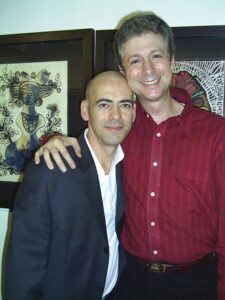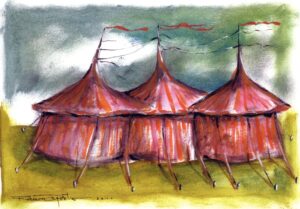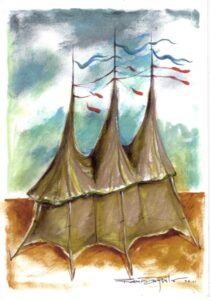
Man and His Masks: The Circus of Ramón Unzueta.
By Roberto Uría

We are given a face we do not choose. But our masks, our characters on the world’s stage are absolute manifestations of the free will with which God endowed us, to compensate for certain fatalisms. Due to this inescapable fact, artists and writers of all epochs have been very interested in exploring these assumed identities, taken on, temporarily or permanently, in life’s game of Chess: masked balls, carnivals, royal courts, politics, theatre or circuses. To this last universe of clowns, acrobats and travelling musicians, Ramón Unzueta dedicated a good part of his vast plastic work.
While it is true that his female characters are more prominent in the work of this Cuban painter, who dedicated himself to explore the souls of film and Kabuki theatre actresses, suffering women and women from Havana neighborhoods, it is also true that his sailors, his angels, his little peasants, his male nudes and his clowns have a relevance deserving of study or of permanent expositionin the best art galleries.
With the same great creative care with which he portrayed the human form and played with it in a daring game that encompassed from correctly decorative aesthetic “perfection” (like his ladies from Seville) to a total distortion in search of the grotesque or the absurd that seeks to draw moods and human conditions, or simply to give us the gift humor, Unzueta creates a circus-like universe full of surprises within the rich universal tradition of portraying this popular entertainment venue with its hidden tragedies, its violent contrasts and its wandering humans beings, givers of joy, but maybe, abysmally sad, nomad sowers of nostalgia and dreams.

And so, the sum of the pieces he dedicated to the theme of the circus is much closer, in spirit and in concept, to the work of Pablo Picasso, who also concentrated on the intimate and human essence, almost one of family, of the circus fauna, and not to the colorful spectacle phase, as in the work of Fernando Botero, which massively portrays the theatrical scaffolding, even with animals, in a bewildering baroque. In contrast, in Unzueta’s work the circus is loneliness, with those lone figures on the canvas, almost without scenography, although with very elaborate costumes and details that manifest a possible x-ray of the character’s soul.
As an example, there is his clown without music, holding a green violin, with all the strings broken, yet he has not renounced the bow, which he holds in his other hand, suggesting that there is hope that he will play his melodies again; or that other solitary clown that hangs from his cap from an aerial clothesline, but one that is absolutely resistant, like the thread of a stubborn spider or the thread that ties us to life, to anyone, but that is ours; or also those female acrobats, a tightrope walker on a monocycle, umbrella in hand, with the most anguished expression imaginable on her face, and the other one, holding on to a ring that hangs from another subtle string, as if of black sand, with her serpent wrapped around her waist, a humongous red feather on her head and, in her other hand, hanging from a string, an immaculate red apple, a heart lying in the labyrinthine wind of life, possessed by temptations.
The improvised verse duel between the intensely purple mouths, with their smiles coined for the spectacle, which must go on despite all, and the eyes that exude loneliness, anguish, sadness and mysteries, is Unzueta’s very personal stamp. In this suggestive dialogue between the two essential parts of these masks, real faces, the eyes overflow, become disproportionate, cry black tears or scream their silences, and they win the golden palms of expressiveness.
Here the paint brushes, so wise and accurate when drawing the lines of a race (I think of his black virgins and his oriental characters), of an androgynous beingor when exalting feminine or masculine beauty, gain absolute freedom and distort left and right, until they bind us to the gaze of those harlequins, clowns and acrobats so human and so alive, so winged in their questionings.
As faithful allies the artist has the very elaborate colors that encompass an intense range of electric blues, potent greens, fiery yellows and reds, limpid whites, or grays and browns that invade outfits, caps, skies and curtains and complete this fascinating cosmos, an eternal subject in plastic art.

A special mention must be made of his circus tents, those enormous awnings that, like a holy trinity of strength, delirium and pain, drive their tentacles into the earth, like a ferocious animal that howls under tempestuous skies and envelops that life of the spectacle that is about to begin dispensing a piece of eternity. His tents are few, but they are probably the most disturbing of those in Cuban plastic art that have tackled this recurrent motif.
The circus always catapults us to childhood, to those years when we began to eagerly explore the world, not knowing that this, inevitably, throws us into adulthood, so harsh and mortal. When we have grown into adulthood, to reach this circus by the hand of an artist like Unzueta, who never stopped being a child, and that is why he is big, is a complex experience in which nostalgia mixes with fright before the passing of time, as revealed by these seductive pieces, masks of an exceptional man and artist.